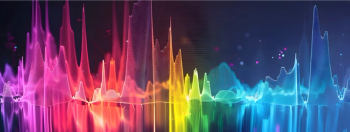
- Spectroscopy-04-01-2007
- Volume 23
- Issue 4
Wavelength Standards for the Near-Infrared Spectral Region
This article compares three regulatory standards for near-infrared wavelength references and then reviews currently available materials. Reference types discussed include gas and vapor band spectra, solid artifacts in both transmittance and reflectance, and liquids in transmittance. Traceability issues are discussed in connection with calibration and qualification regulatory compliance requirements, particularly for the pharmaceutical and medical device industries.
The near-infrared (NIR) spectral region lies approximately from 780 nm to 2500 nm (4000 cm–1 to 12,800 cm–1) bridging the more well known and analytically used regions of the UV–vis (190–780 nm) and the infrared (4000–600 cm–1). Until relatively recently, it has been called the "forgotten" region. However, with the arrival of Fourier transform (FT)–NIR instruments in the 1990s and the increasing awareness of the NIR's unique information content in the signal, which can provide both physical and chemical information, deployment of NIR spectrometry systems for both qualitative and quantitative purposes has become widespread, particularly in the pharmaceutical industry. This application in the NIR has led to new standards being generated by ASTM (1,2).
This renewed interest has led to the need for traceable standards for the calibration and qualification of the wavelength scale of NIR spectrometers in the regulated environment. The purpose of this article is to review the current position with respect to wavelength standards availability and traceability.
Because of the versatility in the sample presentation modes in the NIR, there is a need to ensure wavelength accuracy in transmittance, reflectance, and transflectance. For dispersive instruments, wavelength precision is also important because of the use of mechanical wavelength drives. However, for modern FT instruments, the precision is so good that only the accuracy of the wavelength scale is important.
The wavelength scale accuracy is important because of the excellent signal-to-noise ratio (S/N) of the NIR, especially in the region above 1200 nm. This facet means that small changes in the spectral response function are spectroscopically significant; hence, transfer of spectral information between different NIR systems becomes problematic if the wavelength shifts, among others, are not controlled. Regulatory interest has led to the promulgation of monographs for the specification, calibration, and control of NIR spectrometers in both the U.S. (3) and European Pharmacopoeias (4). Unfortunately, these monographs have not been harmonized, and there are significant differences.
In addition, some of the wavelength requirements are unsound scientifically. For example, USP General Chapter <1119> recommends the use of NIST SRM 2034, which is not certified by NIST for use in this region, and EP 2.2.40 gives a value of a water vapor line of 7299.86 cm–1 without reference to its source and is demonstrably wrong (see section on water vapor for more details). One other source of wavelength calibration information is ASTM E275-01 (5) (currently under revision). This document recommends a third and different set of wavelength standards for the NIR.
These three documents are summarized in Table I. In addition, other standards have been proposed for transmission mode, including trichloromethane (6), SRM 2036 (7), and polystyrene (8) for quality control.
Table I: Comparison of the three major documents on wavelength calibration
This article will review some of these standards from the perspective of traceability, "fitness for purpose," and practical ease of use.
Atomic and Molecular Band Spectra
The use of atomic and molecular lines for the calibration of spectrometers is attractive scientifically because they often are linked to primary standards. However, the use of atomic line sources can present practical difficulties for end-users, especially for instruments designed to work in a routine environment. Instrument manufacturers often use these sources during instrument building and commissioning.
High-Pressure Mercury Arc
One of the difficulties is finding traceable values for these lines. Table II lists the 19 most intense lines from neutral Hgz = 80 listed in the CRC Handbook of Chemistry and Physics, 87th Ed., 2006, and compares them with those listed in ASTM 275-01. The agreement is within the ASTM 275-01 rounding of the values, which are quoted in micrometers. Traceability support for these values is found in the NBS papers of Pyler (9,10) and Humphries (11). These tabulated values probably are sufficiently accurate for most dispersive spectrometers. For FT instruments, the values to full experimental precision probably would be required.
Table II: Mercury line wavelengths in air for the spectral region 670 to 2325 nm
Water Vapor
The use of water vapor as a wavelength standard is very attractive, as it does not require the use of an artifact and is readily observable in single beam mode. The NIR spectrum of water is exceedingly complex. However, this has been explored extensively for the purposes of climate studies, and the HITRAN 2004 database (12) is the definitive source of values. The spectral region usually chosen for calibration is in the band set in the region of 7300 cm–1 (1369 nm). Additional problems are that the wavenumber's conversion is dependent upon the refractive index of air and the spectra are heavily resolution-dependent. The wavenumber conversion is by the following formula:
For FT instruments, a resolution of 2 cm–1 is needed to resolve the key band positions. For dispersive instruments, an SBW of 0.5 or better is required. The value cited in the EP of 7299.86 cm–1 for water vapor is incorrect according to the HITRAN 2004 database.
Table III: Water vapor calibration bands from the HITRAN 2004 database
The HITRAN 2004 value is 7299.43107 cm–1 (to nine significant figures) (1369.59 nm). The strongest bands in this region are shown in Table III, and a partial spectrum is shown in Figure 1 with the values given in nm.
Figure 1
Gas Standards (NIST SRM 2517 and SRM 2519)
SRM 2517 is a single-mode optical-fiber-coupled absorption cell containing acetylene (C2H2) gas at a pressure of 6.7 kPa (50 torr), for use in the 1510–1550 nm region. With a pathlength of 5 cm, the cell is packaged as a small instrument box, with two FC/PC fiber connectors for the input and output of a user-supplied light source. This SRM can be used for high-resolution applications, having more than 50 accurately measured absorption lines in this region, with an expanded uncertainty of 0.00006 nm (13,14). This is shown in Figure 2.
Figure 2
SRM 2519 is a similar gas reference, but it uses hydrogen cyanide as the wavelength calibrant (15). A total of 51 lines from 1528–1563 nm are certified — 21 with an expanded uncertainty of 0.00006 nm and the rest with an expanded uncertainty of 0.0003 nm. The equivalent spectrum is shown in Figure 3.
Figure 3
At this accuracy (with nanometer values quoted to nine significant figures) and these uncertainty levels, these gas standards essentially become primary standards for wavelength calibration, but the format and fiber-optic requirement tends to limit their areas of use to research applications and laser-based systems.
Solid Artifacts in Transmission
REO glasses (NIST SRM 2035 & SRM 2065)
After various discussions with interested parties in the fall of 1994, NIST started development of an NIR reference with the following design specification:
- Wavelength coverage from at least 1000 nm to 2000 nm (10,000–5000 cm–1).
- Peak location precision of at least 0.02 nm (≈ 0.2 cm–1).
- Wavelength accuracy better than 0.1 nm (≈ 1 cm–1).
- Fairly broad and symmetrical peaks.
- Readily available.
This specification was designed to assist the development of chemometric methodology and to render the standard relatively insensitive to changes in resolution on a moderately high-resolution instrument (16).
Figure 4
These requirements led to the certification of SRM 2035, a batch certified material, containing a mixture of the oxides of samarium, ytterbium, and holmium in a zirconia-stabilized borate matrix.
It provides certified values (band locations and associated 95% uncertainty limits) for seven fairly symmetric and uniformly spaced bands from 976 nm to1946 nm (≈ 10,250–5139 cm–1). The original batch of 100 filters was evaluated for homogeneity on a range of both dispersive and FT–NIR instruments, and subsequent batches (SRM 2035a) show band variation (compared to the original batch) of less than 1 cm–1 (0.2 nm) for the seven certified bands.
To achieve the precision specification mentioned earlier required a very robust peak assessment algorithm. After extensive testing, a center-of-gravity (COG) method was chosen. This method has been criticized for defining a band value significantly different from the visual peak maximum, especially for asymmetrical peaks (17).
Figure 5
While the debate continues, NIST does provide on the SRM 2035 certification "information values" for the peak locations using a peak amplitude method. However, there are no uncertainty budgets associated with these values, as NIST considers these to be "a value that will be of interest and use to the user, but insufficient information is available to access the uncertainty associated with the value." While the temperature coefficient associated with the band assignment of 0.1 cm–1 °C–1 (< 0.02 nm/°C) will not make a significant contribution to laboratory usage of this reference, the effect in environments not at 25 °C must be taken into account (18).
There are significant discrepancies from these informational values for FT–NIR instruments even though the water vapor calibration data are within ± 0.1 nm. For example, at 8 cm–1 the following data, rounded to ± 0.1 nm, were observed (NIST Table IV data from reference 18 are given in brackets for the seven absorbance maxima in nanometers; 975.9 [975.8], 1077.3 [1075.7], 1151.9 [1151.7], 1224.1 [1222.5], 1368.9 [1366.8], 1471.8 [1469.4], and 1945.4 [1945.7]).
Table IV: Comparison of dispersive wavelength maxima values with three FTâNIR instruments
NIST SRM 2065 is essentially the same physical standard as SRM 2035 and is certified for the location of the seven absorbance bands (COG) in the spectral region from 10,300 cm–1 to 5130 cm–1 at 4-cm–1 resolution. SRM 2065 is also certified for the location of seven absorbance bands in the spectral region from 970 nm to 1946 nm and 13 additional transmittance peaks spanning the spectral region from 334 nm to 805 nm.
McCrone M-27 and Nelson M-42
In the late 1980s, a series of new rare earth-doped materials in a monocrystalline host material were developed (19). These doped yttrium aluminum garnet–type crystals have the property of having sharper and more numerous absorption peaks than the previous "didymium" type of glasses. The first one, M-27 (neodymium doped), had excellent lines within the UV-vis region but only had three lines in the NIR, at 869.2, 1486.2, and 1735.2 nm at a spectral bandwidth of 1 nm.
Figure 6
A more recent material, M-42, has the same crystal structure but contains europium as the dopant and has the chemical composition Y3Er3Al10O24. From an artifact point of view, it is ideal in that it is stable and mechanically robust. However, the lines are sharp but concentrated into two groups. The resolution required is quite high: 0.5 nm SBW or 2 cm–1 resolution or better. It is not currently known how these band maxima will behave with changes in SBW and resolution.
Polystyrene
Polystyrene (38-μm thick) is used commonly as an infrared reference because the raw material is readily available for a low cost. What is its potential in the NIR region? As the absorptivities of the carbon–hydrogen combination and overtone bands decrease significantly toward shorter wavelengths, this material is unlikely to provide features of adequate intensity to cover the entire NIR wavelength range. In March 2000, it was suggested that the calibration of a thicker polystyrene reference using a "region overlap" approach could be achieved effectively by using appropriate certified bands of NIST SRM 1921a (20). In 2000, a study at NIST using polystyrene from four suppliers showed the average peak maximum differences to be less than 0.1 nm for eight bands in the 2.5–12.5 μm region. However, in the 1–2 μm region, source-specific differences were noted, where the bands are weaker and more asymmetric.
Figure 7
For these reasons, a number of spectrometer vendors are currently using 0.75–2 mm thick polystyrene as an internal reference material for wavelength qualification and control. However, while polystyrene possesses reasonably sharp bands, their asymmetric nature means that any peak value assignment is strongly dependent upon the spectral resolution of the instrument.
Solid Artifacts in Reflectance
NIST SRM 1920, SRM 2036 and European Pharmacopoeia REO mixture
SRM 1920 is a mixture of three rare earth oxides, dysprosium oxide (Dy2O3), erbium oxide (Er2O3), and holmium oxide (Ho2O3), which has been pressed into a cavity and sealed behind an IR-transmitting sapphire window. It is no longer available from NIST, but similar materials are available commercially, many of which are based upon sintering the rare earth oxides in an inert, durable, spectrally neutral matrix. These have the benefit that the specular reflection from the sapphire window is eliminated, but the sintering process can cause minor peak shifts when compared to SRM 1920 (21).
With many NIR instrument systems using fiber probes that operate in transflectance, where the NIR radiation is reflected after transversing the sample and passes through the sample again before detection, NIST realized the requirement for a new diffuse reflectance wavelength standard.
SRM 2036 is this standard. It provides the same level of calibration confidence as NIST's existing SRM 1920a but is easier to produce, utilizes the same materials as SRM 2035 and SRM 2065, and eliminates the strong dependence of band position on the resolution of the instrument that is inherent in the use of SRM 1920. It also enables the calibration of a number of common sampling accessories currently in use by the pharmaceutical industry. Because SRM 1920 is no longer available from NIST, this is their suggested replacement.
SRM 2036 is a glass that is compositionally identical to SRM 2065 physically contacted with a piece of 6-mm-thick sintered polytetrafluoroethylene (PTFE). The combination of the rare earth oxide glass with a nearly ideal diffuse reflector provides reflection-absorption bands that range from approximately 15–40% R. SRM 2036 is certified for the 10% band fraction centroid of seven bands spanning the spectral region from 975 nm to 1946 nm (air wavelength). In addition, it is certified for the 10% band fraction centroid location of the same seven bands in the spectral region from 10,300 cm–1 to 5130 cm–1 at 8-cm–1 resolution (vacuum wavenumber) (22).
Liquid Standards
Traceable liquid standards, sealed in quartz cuvettes, are attractive to endusers for calibration or qualification purposes because they often mimic their standard measurement process and do not require specialist knowledge or apparatus. Several chlorinated solvent-based wavelength standards have been proposed for use in this way in the NIR. Two, 1,2,4-trichlorobenzene and methylene chloride, have been described in standard publications but suffer from some deficiencies as outlined in the following sections.
Trichlorobenzene
1,2,4-Trichlorobenzene, at a 1-mm pathlength has seven bands with the attributed wavelengths of 1660.6, 2152.6, 2312.6, 2403.0, 2437.4, 2494.0, and 2543.0 nm (23).
These bands are considerably asymmetric, have a limited wavelength range (Figure 8), and rely on a single paper from NBS from 1957.
Figure 8
Methylene Chloride and Admixture with Titanium(IV) Oxide
The European Pharmacopoeia selected methylene chloride for use as a wavelength calibrant for both transmission and reflectance modes. In the former, the pathlength described is 1 mm and for reflectance some titanium(IV) oxide is added, and the mixture shaken and allowed to settle. The titanium(IV) oxide is spectrally neutral over the NIR spectral region and merely provides a diffuse reflectance matrix. Typical spectra are shown in Figure 9.
Figure 9
Methylene chloride has eight characteristic sharp bands (according to the EP (4)) at 1155, 1366, 1417, 1690, 1838, 1894, 2068, and 2245 nm. The bands at 1155, 1417, 1690, and 2245 nm are specified for use in spectrometer calibration. However, no traceability information is given and the bands below 1600 nm are fairly weak. In addition, the band assignment positions are not sufficiently specified for high-resolution FT–NIR spectrometers. The band at 2245 nm is too strong for accurate measurement for a 1-mm path because it has an absorbance of >3, although in reflectance the value is <2.
To overcome the deficiencies of trichlorobenzene and methylene chloride, a new traceable liquid wavelength standard, TS5, has been developed (24) in a standard 10-mm path cuvette. This new liquid standard has the advantage in that it has 13 well-characterized peaks covering the normal NIR spectrometer range. A typical spectrum is shown in Figure 10.
Figure 10
The wavelength maxima are not significantly susceptible to shifts of temperature in the range 15–40 °C. In addition, the standard is relatively insensitive to changes in resolution. Table IV shows development data of TS5 wavelength measurements in a fused-quartz cuvette of a standard 10-mm pathlength as a function of spectral resolution. Four instruments were involved, one dispersive (Cary 500) and three FT–NIRs from different manufacturers. The TS5 standard has a built-in 5-mm path transflectance mode in addition to the 10-mm transmittance path. The results are encouraging in that the observed differences are generally less than 1 nm and the difference between FT instruments within a given resolution is generally 0.5 nm or better.
Summary and Conclusions
A number of standards for wavelength calibration of NIR spectrometers are available. They are summarized in Table V.
Table V: Summary of main wavelength standards for the NIR region
For instrument manufacturers with access to specialist equipment, the use of atomic lines and traceable NIST gas standards might be the preferred option because of the wavelength accuracy associated with these references. However, unless already built into a given instrument, correct physical and optical alignment can be critical and time-consuming.
For most endusers, the use of a solid artifact or standard cuvette for wavelength calibration for either transmission or reflectance calibration is generally preferred for ease of use and its similarity in mode of presentation to the actual sample. However, in many regulated environments, the essential requirement for traceability of the measurement value highlights the current less-than-ideal situation. There are primary materials available from NIST, but these standards have value assignments that are difficult to validate and are relatively expensive. What is required are solid or liquid secondary standards with associated traceability, analogous to their UV-vis counterparts, and which are readily available from ISO/IEC 17025 (25) and ISO Guide 34 (26) accredited organizations.
Abbreviations used
EP: — European Pharmacopeia
ISO: — International Standards Organization, Geneva
IEC: — International Electrotechnical Committee
NBS: — National Bureau of Standards, USA (now NIST)
NIST: — National Institute of Science and Technology, USA
SRM: — Standard reference material
SBW: — Spectral bandwidth
USP: — United States Pharmacopoeia
Christopher Burgess is with Burgess Consultancy, "Rose Rae," The Lendings, Starforth Barnard Castle, Co. Durham, DL12 9AB, UK;
John Hammond is Technical & Marketing Manager with Starna Scientific Limited, 52-54 Fowler Road, Hainault Business Park, Hainault, Essex, IG6 3UT, UK; http://
References
(1) ASTM E1790-04; Standard Practice for Near Infrared qualitative analysis, ASTM International, 100 Barr Harbor Drive, PO Box C700, West Conshohocken, PA 19428-2959, United States, 2004
(2) ASTM E2056-04; Standard Practice for Qualifying Spectrometers and Spectrophotometers for Use in Multivariate Analyses, Calibrated Using Surrogate Mixtures, ASTM International, 100 Barr Harbor Drive, PO Box C700, West Conshohocken, PA 19428-2959, United States, 2004
(3) USP 28 (2005) General Chapter <1119> Near-Infrared Spectrophotometry.
(4) European Pharmacopoeia 5.0 (2005) 2.2.40 Near-Infrared Spectrophotometry.
(5) ASTM E275-01; Standard practice for describing and measuring performance of ultraviolet, visible and near-infrared spectrophotometers, American Society for Testing Materials, 100 Barr Harbor Drive, West Conshohocken, PA 19428-2959, USA, 2001
(6) K.W. Busch, O. Soyemi, D. Rabbe, K. Humphrey, B. Dundee, and M.A. Busch, Appl. Spectrosc. 54(9), 1321–1326 (2000).
(7) S.J. Choquette, D.L. Duewer, L.M. Hanssen, E.A. Early, Appl. Spectrosc. 59 (4), 496–504 (2005).
(8) S. Lowry, B. McCarthy, and J. Hyatt, Thermo Electron Corporation Technical Note 50772.
(9) E.K. Pyler and C.W. Peters, J. Res. Natl. Bur. Stand. (U.S.) 45(6), 462–468 (1950).
(10) N. Acquista and E.K. Pyler, J. Res. Natl. Bur. Stand. (U.S.) 49(1), 13–168 (1952).
(11) C.J. Humphreys, J. Opt. Soc. Am. 43(11), 1027–1029 (1953).
(12) L.S. Rothman et al., J. Quant. Spectrosc. Radiat. Transfer 96, 139–204 (2005).
(13) SRM 2517a Certificate, National Institute of Standards and Technology, 'High Resolution Wavelength Calibration Reference for 1510 nm – 1540 nm Acetylene 12C2H2', Standard Reference Materials Program, NIST, Gaithersburg, MD, USA.
(14) NIST Special Publication 260-133, 2001 Edition, Standard Reference Materials Acetylene 12C2H2 Absorption Reference for 1510 nm to 1540 nm Wavelength Calibration—SRM 2517a.
(15) NIST Special Publication 260-137, Standard Reference Materials Hydrogen Cyanide H13C14N Absorption Reference for 1530 nm to 1560 nm Wavelength Calibration—SRM 2519.
(16) S.J. Choquette, J.C. Travis, C. Zhu, and D.L. Duewer, Wavenumber Standards for Near-Infrared Spectrometry Handbook of Vibrational Spectroscopy, John Wiley & Sons (available as .pdf at
(17) R.A. Spragg and M. Billingham, Spectroscopy 10(1), 41 (1995).
(18) SRM 2035 Certificate, National Institute of Standards and Technology, 'Standard Reference Material 2035, Near Infrared Transmission Wavelength Standard from 10,300 cm–1 to 5130 cm–1', Standard Reference Materials Program, NIST, Gaithersburg, MD, USA.
(19) Obtainable from Nelson Gemological Instruments, 1 Lydhurst Road, Hampstead, London NW3 5PX, UK
(20) S.R. Lowry, J. Hyatt, and W.J. McCarthy, Appl. Spectrosc. 54(3), 450–455(6) (2000).
(21) SRM 1920a Certificate, National Institute of Standards and Technology, 'Standard Reference Material 1920a, Near Infrared Reflectance Wavelength Standard from 740 nm to 2000 nm', Standard Reference Materials Program, NIST, Gaithersburg, MD, USA.
(22) SRM 2036 Certificate, National Institute of Standards and Technology, "Standard Reference Material 2035, Near Infrared Wavelength/Wavenumber Reflectance Standard," Standard Reference Materials Program, NIST, Gaithersburg, MD, USA.
(23) E.K. Pyler, L.R. Blaine, and M. Nowak, J. Res. Natl. Bur. Stand. (U.S.) 58, 195 (1957).
(24) Starna Scientific Limited, 52-54 Fowler Road, Hainault Industrial Estate, Hainault, Essex IG6 3UT, UK. http://
(25) ISO/IEC 17025:2005, General Requirements for the Competence of Calibration and Testing Laboratories.
(26) ISO Guide 34:2000 General requirements for the competence of reference material producers.
Articles in this issue
over 18 years ago
Market Profile - Spectroscopic Process Water Analysisover 18 years ago
Jelly Beans and Mass Spectrometry for K-4 Studentsover 18 years ago
Product ResourcesNewsletter
Get essential updates on the latest spectroscopy technologies, regulatory standards, and best practices—subscribe today to Spectroscopy.





